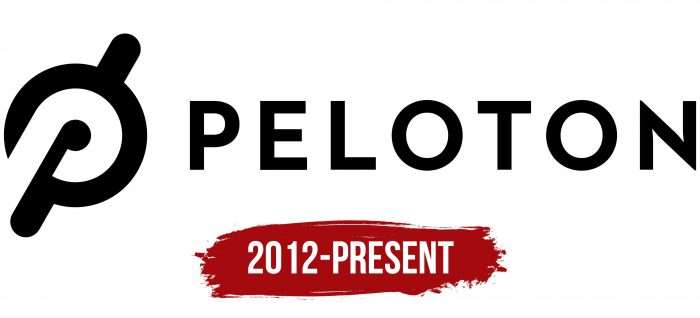Love for sport and movement is the main message of the emblem. The Peloton logo hints at the importance of daily hard work, without which achievement is impossible. And for the effectiveness of the lessons, you can use suitable sports equipment.
Peloton: Brand overview
| Founded: | January 3, 2012 |
| Founder: | Graham Stanton, Hisao Kushi, John Foley, Tom Cortese, Yony Feng |
| Headquarters: | New York City, US |
| Website: | onepeloton.com |
Meaning and History
The more difficult the situation, the more profit Peloton gets. The latest rise in the price of its shares is associated with the COVID-19 pandemic because due to the closure of gyms, sports fans were forced to work out at home. As a result, the demand for home fitness equipment grew so much that the company briefly limited sales due to a shortage of products.
Stocks hit a new all-time high after an exercise bike manufacturer was implicated in a patent infringement case. Paradoxically, Icon Health and Fitness only boosted Peloton’s popularity with its lawsuit.
What is Peloton?
Peloton is the abbreviated name of the American company Peloton Interactive, which manufactures exercise equipment. It mainly offers exercise equipment (treadmills, stationary bicycles) and programs for connecting them to the Internet. The main office of the manufacturer is located in New York.
Another jump in the share price took place against the backdrop of a scandal over defective pedals. In the second half of 2020, people who bought bicycles began to report leg injuries in large numbers. For safety reasons, the company recalled pedals for 27,000 exercise machines. Oddly enough, the unexpected anti-advertising only strengthened its position in the market for electronic fitness equipment.
By the way, the company’s logo also features pedals, but this is no more than a coincidence because the brand name appeared back in 2012. It was invented by Eric Hwang, a graphic designer from New York. The same person led the team that created the interface for Peloton applications.
Since then, the emblem has never changed, ensuring the manufacturer’s recognition and its interactive products. However, it does not convey the full spectrum of what Peloton does. In addition to stationary bicycles, the company produces treadmills and supports Peloton Digital by broadcasting sports activities online.
Peloton: Interesting Facts
Peloton has changed how people work out at home with its high-tech fitness gear and online classes.
- Start-Up Story: John Foley and his team launched Peloton in 2012 to bring gym-like workouts to the home. They used technology to make exercising alone feel like being part of a live class.
- The Original Bike: In 2014, Peloton released its first bike with a big screen for streaming classes, turning your home into a personal gym.
- Quick Rise: Peloton became popular, leading to a public stock offering in 2019. This marked its spot as a big name in the fitness world.
- More Than Cycling: Peloton now offers a variety of classes, including running, yoga, and strength training, catering to all kinds of fitness goals.
- Instructors Worldwide: Peloton’s instructors, from across the globe, aren’t just teachers; they’re like celebrities with their fans, helping grow Peloton’s community.
- Community Feel: The Peloton app lets users join challenges, celebrate achievements, and connect with others, creating a motivating online community.
- Beyond Bikes: Peloton has added more products, like the high-end treadmill Peloton Tread, and updated bikes, always improving its tech to improve workouts.
- Pandemic Boost: COVID-19 made Peloton even more popular as people looked for safe ways to stay fit at home, skyrocketing sales and membership.
- Music Deals: Music is key to Peloton’s classes. They’ve teamed up with big music names to keep workouts fun and energetic.
- Giving Back: Peloton also focuses on making fitness accessible to everyone and fighting racial injustice, promising $100 million to these causes over four years.
Peloton combines the latest in fitness technology with the community vibe of group classes, leading the way in digital fitness.
Font and Colors
Eric Hwang played with the company’s name and the cycling theme interestingly: he combined them into one logo using the first letter of the word “Peloton.” “P” looks like a white spiral that is superimposed on a black circle. A long diagonal strip with rounded edges runs through them. Its middle is located outside the visibility zone: the line seems to pierce the circle on one side and goes out on the other.
The general appearance of the figure resembles that part of the exercise bike where the pedals are attached. The drawing symbolizes movement – and not just literally. In addition to sports, this implies the constant development of a fitness portal. The design seems minimalistic, but this is only at first glance: the image consists of many small details.
The font for the “Peloton” lettering was invented by the same designer Eric Hwang who made the logo. He used Futura and Brandon Grotesque letterings as a base. The modification is a strict sans-serif typeface.
The main version of the logo is black and white. There are also options with red or orange “P” and gray text.
FAQ
Why did Peloton change its logo?
The company changed its logo to change how people see the brand. It wants to be more than a company for a specific lifestyle or income level. Instead, it aims to be a fitness platform for everyone, regardless of age, fitness level, or financial situation.
The new logo reflects this broader vision. It shows Peloton’s commitment to being inclusive and accessible in the fitness world. The brand wants to remove barriers that might have made it seem exclusive or out of reach.
By updating the logo, the company wants to show that its fitness products and services are for everyone. They want to fit into various lifestyles and budgets. This rebranding is part of a larger strategy to attract a more diverse customer base.
What is the Peloton symbol?
The logo features an abstract bike pedal. This design combines a circle with two diagonal lines. Eric, the designer, chose the circle because it symbolizes community, wholeness, and totality.
The abstract bike pedal highlights the brand’s identity, focusing on cycling and fitness. The circle looks like a bike wheel and conveys unity and completeness. The two diagonal lines add movement and energy to the logo. This reflects the brand’s focus on active lifestyles and energetic fitness classes.
What font is the Peloton logo?
The logo has changed over time to reflect the company’s growth. At first, it featured the word “peloton” in bold, lowercase letters using a sleek, sans-serif font. This design showed the brand’s modern and forward-thinking approach.
The sans-serif font gave the logo a clean and contemporary look, matching the company image as a cutting-edge fitness platform. The bold font made the logo strong and easy to recognize.
As the brand grew, the logo was refined to better represent its evolving identity. Despite these changes, the main elements of the original design—modernity, simplicity, and clarity—stayed the same.
What is the Peloton logo?
The Peloton logo combines graphics and text for a distinctive look. The icon on the left is a stylized bike pedal assembly, a key part of the brand’s bikes. This icon resembles the letter “P,” connecting it to the brand name.
Next to the icon is the brand’s name in a clean, modern font. This simple font complements the sleek design of the icon and reinforces Peloton’s image as a modern fitness brand.
The combination of the stylized pedal and simple text creates a balanced logo. It highlights the brand’s focus on cycling and fitness with a modern and approachable design. The logo’s simplicity makes it easy to recognize and remember, strengthening the brand’s identity.
What color is the Peloton logo?
Peloton’s marketing guidelines ensure their logo stands out on any background using a contrasting color palette. The logo is black on light backgrounds and white on dark backgrounds.
This approach keeps the logo visible and impactful on equipment, promotional materials, or digital platforms. The contrasting colors help maintain the brand’s strong and recognizable identity.
Using black and white ensures the logo stays clear and prominent. This simple, versatile color choice matches the brand’s modern image, showing its commitment to quality and consistency.






